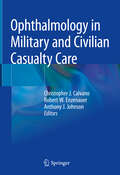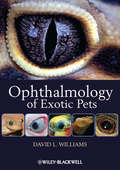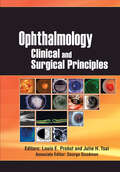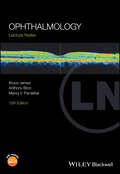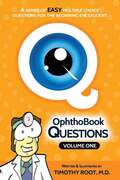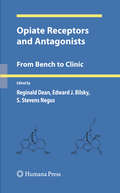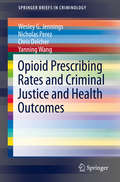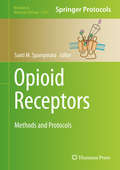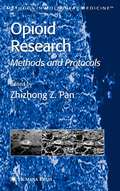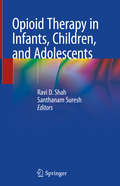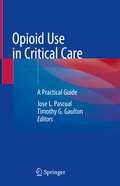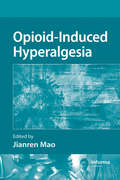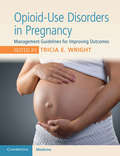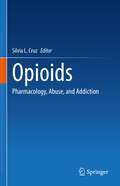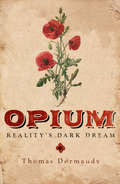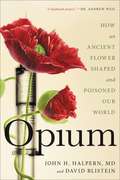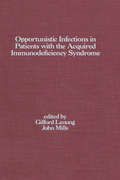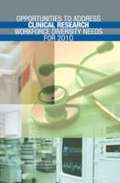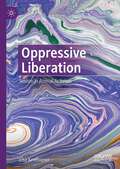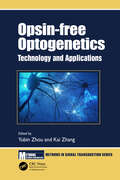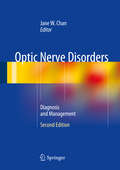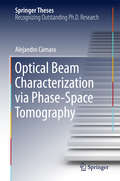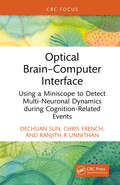- Table View
- List View
Ophthalmology in Military and Civilian Casualty Care
by Christopher J. Calvano Robert W. Enzenauer Anthony J. JohnsonTrauma to the eye and associated structures account for a significant number of combat-related injuries, and combat ocular trauma has steadily risen in frequency over the last century. Ophthalmology in Military and Civilian Casualty Care comprehensively examines the accommodations and modifications that must be made in order to treat such ocular traumas in a military setting.Created by ophthalmology experts actively serving in the military at various levels, this book is designed to improve ophthalmic casualty outcomes across military settings. A history of military ophthalmology serves as the opening chapter, setting the stage for subsequent chapters examining the intricacies and advancements of damage control ophthalmology, prehospital care of combat eye injuries, neuro-ophthalmic manifestations of trauma, and further severe ocular conditions. Later chapters explore the preventative and proactive efforts to reduce and treat combat-related ocular trauma by developing “eye armor” for the American infantry and military-affiliated ophthalmic surgical missions. Complete with high-quality color illustrations and figures, this unique book will serve as an invaluable, practical reference for military physicians, military ophthalmologists, ophthalmology professors, residents, and fellows interested in combat medicine and eye trauma.
Ophthalmology of Exotic Pets
by David L. WilliamsThis quick reference handbook covers the diagnosis and treatment of eye disease in a range of exotic companion animal species, including rabbits, rodents, reptiles, birds, amphibians and fish. It clarifies when extrapolation from cat or dog eyes is appropriate, or when new information is needed to ensure that diagnoses and treatments are appropriate for the particular species. Writing in an accessible and down to earth style, the author brings a wealth of personal experience to this specialised subject area. The book contains many ophthalmic photographs of both anatomy in normal eyes and pathology in abnormal cases. It also includes a separate chapter on the common ophthalmic features of exotic pets, discussing what can be learnt from cross-species comparison and another chapter giving a brief history of comparative ophthalmology.Ophthalmology of Exotic Pets is an invaluable aid for veterinary practitioners and students with an interest in exotic pet species, as well as for veterinary ophthalmologists.KEY FEATURESCovers lagomorphs, rodents, reptiles, birds, amphibians and fish Offers clear guidance for species-specific treatment Facilitates extrapolations from the cat or dog to the exotic eye Written in a concise quick reference format Highly illustrated with colour photographs
Ophthalmology: Clinical and Surgical Principles
by Louis Probst Julie TsaiOphthalmology: Clinical and Surgical Principles is a comprehensive, yet, accessible guide to medical and surgical ophthalmology that succinctly addresses the diagnosis and treatment of all major diseases of the eye. Louis E. Probst, Julie H. Tsai, and George Goodman, along with the 16 world expert subspecialty contributors, have organized the concise, clinically focused, and user-friendly chapters by subspecialty and include the indications, techniques, and complications of common ophthalmic surgical procedures. This attentive chapter organization reflects the way modern-day ophthalmology is practiced.Ophthalmology: Clinical and Surgical Principles delivers practical emphasis, allowing the reader to apply the information into a clinical setting. Residents will additionally benefit from the surgical options discussed for specific disorders. Features:• More than 400 high-quality diagrams, figures, and color photographs.• Diagrams, tables, and figures to facilitate comparisons and assimilation of the information.• References to provide a starting point for further study and research.• Study questions at the conclusion of each chapter to allow readers to test their knowledge and prepare for important examinations.Ophthalmology: Clinical and Surgical Principles is comprehensive and practical enough to be a complete resource for the ophthalmologist, ophthalmology resident, optometrist, as well as family physicians, medical students, and ophthalmic technician.
Ophthalmology: Lecture Notes (Lecture Notes #71)
by Anthony Bron Bruce James Manoj V. ParulekarOPHTHALMOLOGY Lecture Notes Comprehensive yet concise reference and revision guide for ophthalmology, covering all key areas with a systematic and clinical approach Highly illustrated, comprehensive, and accessible, Ophthalmology Lecture Notes is the ideal reference and revision guide to common eye problems and their diagnosis and management. The textbook offers an overview of anatomy, history taking, and examination, but also covers a wide range of core ophthalmic conditions. Sample topics covered in Ophthalmology Lecture Notes include: Anatomy, history, symptoms, and examination, clinical optics, and the orbit, eyelids, and lacrimal system Conjunctiva, cornea, and sclera, the lens and cataract, uveitis, glaucoma, and retina and choroid Retinal vascular disease, the pupil and its responses, disorders of the visual pathway, eye movements and their disorders, and trauma Tropical ophthalmology (eye diseases in the developing world), eye diseases in children and services for the visually handicapped For more information on the complete range of Wiley medical student and junior doctor publishing, please visit: www.wiley.com To receive automatic updates on Wiley books and journals, join our email list. Sign up today at www.wiley.com/email This new edition is also available as an e-book. For more details, please see http://www.wiley.com/buy/9781119905974 All content reviewed by students for students Wiley Medical Education books are designed exactly for their intended audience. All of our books are developed in collaboration with students. This means that our books are always published with you, the student, in mind. If you would like to be one of our student reviewers, go to www.reviewmedicalbooks.com to find out more. This Thirteenth Edition has been thoroughly updated and includes over 200 diagrams and photographs, a range of core cases demonstrating the clinical context of key conditions and learning objectives and summary of key points in each chapter. To aid in reader comprehension, the text also emphasizes vital “must know” knowledge and includes an online self-assessment where all the images from the book are available to download on a companion website. Ophthalmology Lecture Notes is perfect for developing knowledge for clinical practice or revision in the run-up to examinations and uses a systematic approach to provide medical students and junior doctors with all the tools they need to manage clinical situations. It is also ideal for optometrists in training.
Ophthobook Questions - Vol. 1 (Ophthobook Questions Ser.)
by Timothy RootYou've just discovered the coolest question book ever written for the beginning eye student! This book contains over 300 multiple choice questions, sampling every subspecialty within the eye field. It is perfect for the struggling medical student, optometrist, or technician trying to get ahead! 1. These questions are written at a BASIC level for the beginning eye student ... no minutia here! 2. Each question is followed by an explanatory paragraph so you get immediate feedback and learn as you progress! 3. You’ll find hundreds of pictures, cartoons, and mnemonics that improve your retention. Never has studying been this much FUN!
Opiate Receptors and Antagonists
by S. Stevens Negus Reginald Dean Edward J. BilskyComprehensive and authoritative, Opioid Receptors and Antagonists: From Bench to Clinic offers neuroscientists, pharmacologists and interested clinicians a unique survey of the extensive and diverse research efforts currently employed with opioid antagonists to develop novel innovative drug therapies. Summarizes the present understanding of the chemistry, pharmacology and molecular biology of opioid receptors and their subtypes Highlights differences and similarities between the opioid pharmacology of animals and human Describes current and potential therapeutic areas for opioid antagonists, including substance abuse, alcohol and ingestive behaviors, behavioral disorders and other medical indications, supported by nonclinical and clinical evidence Focuses on the development of exciting and innovative drug delivery approaches that are being used with opioid antagonists for the above medical indications
Opioid Prescribing Rates and Criminal Justice and Health Outcomes (SpringerBriefs in Criminology)
by Wesley G. Jennings Chris Delcher Nicholas Perez Yanning WangThis brief uses California’s CURES (Controlled Substance Utilization Review and Evaluation System) 2.0 data to analyze county-level opioid prescribing rates in California from 2012 to 2017 from multiple perspectives. The book summarizes California’s county-level opioid prescribing trends, examines potential correlates of opioid prescribing rates, and assesses the association of opioid prescribing on both criminal justice and public health outcomes. Finally, the authors discuss their principal findings and the implications for policy and practice, including the significant and lasting consequences of the opioid crisis on the criminal justice system and the importance of a multi-disciplinary approach to effectively address the crisis.
Opioid Receptors
by Santi M. SpampinatoOpioid Receptors: Methods and Protocols serves as a comprehensive guide to both key new techniques and established methods for the investigation of genetics, structural biology, transcription, and post-transcriptional events of opioid receptors. Other methods cover the cellular detection and trafficking of opioid receptors in vitro and in vivo. Procedures aimed to investigate signaling pathways modulated by opioid receptors and model systems to study opioid receptor-mediated functions are also included. Finally, methods to assay behavioral effects mediated by opioid receptors are described. Written in the highly successful Methods in Molecular Biology series format, chapters include introductions to their respective introductions, lists of the necessary materials and reagents, step-by-step, readily reproducible laboratory protocols, and tips on troubleshooting and avoiding known pitfalls. Wide-ranging and authoritative, Opioid Receptors: Methods and Protocols will help both experienced and new entrants in this field to carry out their experiments successfully and with new inspiration.
Opioid Reckoning: Love, Loss, and Redemption in the Rehab State
by Amy C. SullivanExamines the complexity and the humanity of the opioid epidemic America&’s opioid epidemic continues to ravage families and communities, despite intense media coverage, federal legislation, criminal prosecutions, and harm reduction efforts to prevent overdose deaths. More than 450,000 Americans have died from opioid overdoses since the late 1990s. In Opioid Reckoning, Amy C. Sullivan explores the complexity of the crisis through firsthand accounts of people grappling with the reverberating effects of stigma, treatment, and recovery. Nearly everyone in the United States has been touched in some way by the opioid epidemic, including the author and her family. Sullivan uses her own story as a launching point to learn how the opioid epidemic challenged longstanding recovery protocols in Minnesota, a state internationally recognized for pioneering addiction treatment. By centering the voices of many people who have experienced opioid use, treatment, recovery, and loss, Sullivan exposes the devastating effects of a one-size-fits-all approach toward treatment of opioid dependency. Taking a clear-eyed, nonjudgmental perspective of every aspect of these issues—drug use, parenting, harm reduction, medication, abstinence, and stigma—Opioid Reckoning questions current treatment models, healthcare inequities, and the criminal justice system. Sullivan also imagines a future where anyone suffering an opioid-use disorder has access to the individualized care, without judgment, available to those with other health problems. Opioid Reckoning presents a captivating look at how the state that invented &“rehab&” addresses the challenges of the opioid epidemic and its overdose deaths while also taking readers into the intimate lives of families, medical and social work professionals, grassroots activists, and many others impacted by the crisis who contribute their insights and potential solutions. In sharing these stories and chronicling their lessons, Sullivan offers a path forward that cultivates empathy, love, and hope for anyone affected by chaotic drug use and its harms.
Opioid Research
by Zhizhong Z. PanThis comprehensive collection of the major cross-disciplinary methods and protocols used in current opioid research covers topics ranging from molecular and genetic techniques, to behavioral analyses of animal models and to clinical practices. The well-practiced authors describe their best molecular techniques for the cloning and expression of opioid receptors, and for the quantitative characterization of their signaling pathways, as well as for mapping the distribution and detecting the expression levels of opioid receptors, opioid peptides, and their messages in both brain tissues and individual cells. Also included are methods for the creation of in vitro and in vivo animal models to study opioid functions, as well as the clinical applications in the treatment of pain and opioid addiction.
Opioid Therapy in Infants, Children, and Adolescents
by Santhanam Suresh Ravi D. ShahOpioid analgesics are among the most effective medications for pain management but are associated with serious and increasing public health problems, including abuse, addiction, and death from overdose. Currently, there is an opioid epidemic in the United States with the rate of prescription opioid-related overdose deaths quadrupling over the last 15 years. Pediatric patients are particularly vulnerable to the devastating consequences of opioid misuse. Adolescents who are prescribed opioids are at a higher risk for abusing illicit drugs later in life. Clinicians managing pediatric pain must account for such issues while still delivering effective analgesia to young patients who suffer from both acute and chronic pain. Opioid Therapy in Children and Adolescents is designed to explore the unique aspects of opioid therapy in pediatric patients. An introductory framework provides historical context and describes the epidemiology of the opioid crisis with focus on pediatric implications. Subsequent chapters focus on pediatric opioid pharmacology, safe opioid prescribing practices, and non-opioid alternatives to managing pediatric pain states, including multimodal analgesic strategies, interdisciplinary approaches, and complementary medicine. Mitigation strategies against pediatric opioid diversion and misuse are addressed to help clinicians develop practice changes that protect pediatric patients from opioid-related morbidity and mortality. Clinical case examples are also utilized throughout the text to provide grounding for each chapter and a context within which to examine pertinent issues. This first of its kind book provides a comprehensive approach that will guide clinicians to appropriately and safely prescribe opioid analgesics to pediatric patients suffering from pain. It is an invaluable resource for pediatricians, family practitioners, anesthesiologists, pediatric oncologists, and other clinicians who manage pediatric pain.
Opioid Use in Critical Care: A Practical Guide
by Jose L. Pascual Timothy G. GaultonThis book provides a concise yet comprehensive overview on the use of opioids in the ICU, offering practical, real-world recommendations on opioid utilization and alternative therapies. The text explains the physiology and assessment of pain and the need for analgesia in the ICU, details the pharmacology of opioids and their use in providing analgesia, sedation, and comfort for patients during critical illness, and summarizes advanced pharmaceutical and surgical approaches to pain management and procedural applications that can supplement, minimize, or replace opioids for the ICU patient. The book also includes algorithms and step-by-step approaches on navigating the delicate balance between the relief of suffering and the adverse effects of opioids, as well as a dedicated section on the management of critically ill patients with preexisting opioid tolerance. Written by experts in the field, Opioid Use in Critical Care: A Practical Guide is a valuable resource for ICU providers who treat and manage critically ill patients with opioids.
Opioid-Induced Hyperalgesia
by Jianren MaoThe first clinically focused text dedicated to the newly emerging area of pain medicine known as opioid-induced hyperalgesia (OIH), Opioid-Induced Hyperalgesia provides pain specialists, anesthesiologists, and neurologists with the most current, cutting-edge research and therapeutic options for treating OIH patients. It supplies best practice guide
Opioid-Use Disorders in Pregnancy: Management Guidelines for Improving Outcomes
by Tricia E. WrightThis book will help readers gain vital guidance and support when treating the high-risk, high-reward population of women confronting (or battling) opioid-use disorders during pregnancy. <P><P>Large numbers of pregnant women are dependent on opioids and require comprehensive non-judgemental care to replace traditional approaches of incarceration and child welfare involvement that worsen outcomes for both mother and infant. Invaluable and comprehensive, this toolkit provides the key to non-judgemental care for both mother and baby, throughout labor, delivery management and postpartum care. It bridges the important treatment gap through evidence-based, caring approach; standardizing exceptional care, for obstetricians, pediatricians, addictionists, and anyone caring for pregnant women with opioid-use disorders.<P> Edited by a Board-certified expert in obstetrics, gynecology and addiction medicine, and a team of internationally-acclaimed leaders in women's health, this guide provides high-quality advice, guidelines and vital skills to tackle a currently expanding opioid epidemic.<P> Addresses the challenges of opioid-specific addiction in pregnant women.<P> Tackles a timely subject manner, providing readers with current management guidelines for this challenging patient population and growing epidemic.<P> Provides comprehensive guidance to caring for both mother and baby in high-risk situations, measured against traditional methods.
Opioids: Pharmacology, Abuse, and Addiction
by Silvia L. CruzOpioids are responsible for the vast majority of preventable deaths related to drug use, and opioid crisis is a serious international health problem. Opioids are also the mainstay in pain treatment and are invaluable tools in palliative care. The purpose of this book is to present an overview of the complex field of opioid pharmacology through evidence-based chapters in clear language backed up with sound scientific evidence, providing researchers and health professionals with a firm understanding of their effects and mechanisms of action. The authors present an overview of the history of opioids from ancient civilizations to the current opioid crisis, covering state-of-the-art advances on opioid-induced signal transduction, opioids in pain management, and the neuroinflammatory effects of opioids. Also discussed are opioid use disorders and their treatment. The authors also review the growing body of evidence of opioid effects on innate and adaptive immune responses, discussing the molecules involved in the crosstalk between opioids and innate immunity receptors to provide an updated view of those compounds as important regulators of inflammation and host defense against pathogens and damage. The overall purpose is to provide the reader with a deeper knowledge of this field despite the complexities associated with the existence of numerous ligands, receptor subtypes, and complex pharmacological profiles. To this end, the chapter authors are specialists in the field who also have extensive experience in teaching, hoping to lend their expertise in translating complex concepts into comprehensive and clear explanations.
Opium Reality's Dark Dream
by Thomas DormandyOpium and its derivatives morphine and heroin have destroyed, corrupted, and killed individuals, families, communities, and even whole nations. And yet, for most of its long history, opium has also been humanity's most effective means of alleviating physical and mental pain. This extraordinary book encompasses the entire history of the world's most fascinating drug, from the first evidence of poppy cultivation by stone-age man to the present-day opium trade in Afghanistan. Dr. Thomas Dormandy tells the story with verve and insight, uncovering the strange power of opiates to motivate major conflicts yet also inspire great art and medical breakthroughs, to trigger the rise of global criminal networks yet also revolutionize attitudes toward well-being. Opium: Reality's Dark Dreamtraverses the globe and the centuries, exploring opium's role in colonialism, the Chinese Opium Wars, laudanum-inspired sublime Romantic poetry, American "Yellow Peril" fears, the rise of the Mafia and the black market, 1960s counterculture, and more. Dr. Dormandy also recounts exotic or sad stories of individual addiction. Throughout the book the author emphasizes opium's complex, valuable relationship with developments in medicine, health, and disease, highlighting the perplexing dual nature of the drug as both the cause and relief of great suffering in widely diverse civilizations.
Opium: How an Ancient Flower Shaped and Poisoned Our World
by David Blistein John H. Halpern"A landmark project." -- Dr. Andrew Weil"Engrossing and highly readable." -- Sam Quinones"An astonishing journey through time and space." -- Julie Holland, MD"The most important, provocative, and challenging book I've read in a long time." -- Laurence BergreenFrom a psychiatrist on the frontlines of addiction medicine and an expert on the history of drug use, comes the "authoritative, engaging, and accessible" (Booklist) history of the flower that helped to build -- and now threatens -- modern society.Opioid addiction is fast becoming the most deadly crisis in American history. In 2018, it claimed nearly fifty thousand lives -- more than gunshots and car crashes combined, and almost as many Americans as were killed in the entire Vietnam War. But even as the overdose crisis ravages our nation -- straining our prison system, dividing families, and defying virtually every legislative solution to treat it -- few understand how it came to be. Opium tells the extraordinary and at times harrowing tale of how we arrived at today's crisis, "mak[ing] timely and startling connections among painkillers, politics, finance, and society" (Laurence Bergreen). The story begins with the discovery of poppy artifacts in ancient Mesopotamia, and goes on to explore how Greek physicians and obscure chemists discovered opium's effects and refined its power, how colonial empires marketed it around the world, and eventually how international drug companies developed a range of powerful synthetic opioids that led to an epidemic of addiction. Throughout, Dr. John Halpern and David Blistein reveal the fascinating role that opium has played in building our modern world, from trade networks to medical protocols to drug enforcement policies. Most importantly, they disentangle how crucial misjudgments, patterns of greed, and racial stereotypes served to transform one of nature's most effective painkillers into a source of unspeakable pain -- and how, using the insights of history, state-of-the-art science, and a compassionate approach to the illness of addiction, we can overcome today's overdose epidemic. This urgent and masterfully woven narrative tells an epic story of how one beautiful flower became the fascination of leaders, tycoons, and nations through the centuries and in their hands exposed the fragility of our civilization.
Opportunistic Infections in Patients with the Acquired Immunodeficiency Syndrome
by John Mills Gifford LeoungThis book provides an overview of background information on the epidemiology, biology, and pathophysiology of HIV infection. It presents the spectrum of HIV disease from acute infection to specific syndrome. The book reviews the management of specific opportunistic infections.
Opportunities to Address Clinical Research Workforce Diversity Needs for 2010
by National Research Council Institute of Medicine of the National AcademiesBased on a 2003 workshop, this study describes current public and private programs and recommends ways to recruit and retain more women and underrepresented minorities into clinical research, especially physician-scientists and nurses. Federal sponsors should improve data collection, evaluate existing training programs, and increase the diversity of study section review panels. Public and private sponsors should create funding mechanisms with flexible career paths, and universities and professional societies should both play enhanced roles in fostering diversity. A significant push is needed to recruit minorities into nursing and provide more clinical research training for nurse-scientists, nursing students, and nursing faculty.
Oppressive Liberation: Sexism in Animal Activism
by Lisa KemmererWhile explicitly set against a backdrop of sexism in social justice activism more generally, this book exposes causes, pervasiveness, harms, and possible directions for change with regard to sexism and male privilege in the animal activist movement. Employing the work of previous scholars, Dr. Lisa Kemmerer exposes the commonplace nature and causes of sexism and male privilege in social justice activism, then focuses on anymal activists, including new data that has not previously been published. The book also explores the crushing harms caused by sexism in the movement and an extensive array of possible directions for change. In various places throughout the text, Kemmerer refocuses on the interface of sexism and speciesism, and one full chapter explores a philosophies of interconnection from around the world and down through time. Also included are six essays from contributing authors who offer fresh angles on the topic, and who provide contextualized experiences with intersectional oppressions. While the book focuses specifically on animal activism, the end-goal of the book is total liberation—an end to all forms of privilege and marginalization.
Opsin-free Optogenetics: Technology and Applications (Methods in Signal Transduction Series)
by Kai Zhang Yubin ZhouOptogenetics represents a breakthrough technology capable of dynamically modulating molecular and cellular activity in live cells with high precision. This transformative technology made it possible to reversibly interrogate protein actions, cellular events, and animal behaviors with a simple flash of light. Manipulating the temporal and spatial profile of light enabled precise control of membrane potentials. This feature has inspired non-opsin-based optogenetics, which not only inherits the precise spatiotemporal resolution but also expands the targets into a diverse pool of biomolecules such as membrane receptors, ion channels, kinases, GTPases, and transcription factors. This book is unique because it emphasizes the design and applications of opsin-free optogenetic tools. Key Features Describes new developments in non-opsin-based optogenetic tools Introduces cutting-edge methods for precise modulation of cell signaling Highlights applications of optogenetic regulation of cellular functions Covers contributions from an international team of leading experts Related Titles Lim, W. & B. Mayer – Cell Signaling (ISBN 9780815342441) Ayyanathan, K., ed. – Cancer Cell Signaling: Targeting Signaling Pathways Toward Therapeutic Approaches to Cancer (ISBN 9781774630839) Zhang , J. et al., eds. – Optical Probes in Biology (ISBN 9781138199934)
Opt Out on Obamacare, Opt Into the Private Health Care Revolution
by John TorinusHeading into 2014, American businesses face an important decision about health care: Opt in or opt out? With the Patient Protection and Affordable Care Act, or Obamacare, in effect, companies with more than 50 employees will either offer health care benefits or face penalties. And the choice isn't as straightforward as it may sound—in many instances, some companies could save money by paying the fines rather than funding a health care plan. Others would lose money if they dropped coverage. Most employers would like to offer the benefit, but it needs to be truly affordable. Fortunately, the stampede of innovations introduced in the private sector over the last decade has simplified the decision; health costs can be managed if corporate managers make it a strategic priority. John Torinus Jr., author of The Company That Solved Health Care, the eye-opening book detailing one company's game-changing health care program, now gives Opt Out on Obamacare, Opt Into the Private Health Care Revolution, a game plan for improving workforce health and dramatically lowering health costs. Unlike the new national law, it concentrates on management science, not politics. Innovative corporations have engaged their employees in taming the hyper-inflation that has plagued the health care industry for decades. CEOs, CFOs, and COOs in front-running companies are deploying management disciplines and marketplace principles to invent a better business model for health care. They are bending the curve, and this book shows you how to follow suit.
Optic Nerve Disorders
by Jane W. ChanOptic Nerve Disorders: Diagnosis and Management, Second Edition, is a thoroughly revised and updated reference, including new information on diagnostic techniques such as genetic testing for hereditary optic neuropathies, new data on toxic/drug-related optic neuropathies and recent data from clinical trial studies. Additional novel therapies, including stem cell therapies, the use of nanotechnology and gene therapies are featured highlights, as is spectral domain optical coherence tomography (OCT) for imaging of the optic nerve. The way in which OCT is used in differentiating optic nerve disorders from other retinal disorders and how OCT is used in monitoring the course of the disease, is also discussed. This practical reference focuses on common optic nerve disorders. It addresses diagnosis, pathophysiology, management and prognosis and is written in a clear, concise style for quick, easy reference in the clinic. With additional color photographs to better illustrate the material, the second edition will prove to be the go-to reference for ophthalmologists, neurologists and neurosurgeons working with optic nerve disorders.
Optical Beam Characterization via Phase-Space Tomography
by Alejandro CámaraThis thesis focuses on the fundamental problem of characterising partially coherent beams. The book describes several non-interferometric methods based on phase-space tomography for recovering the spatial coherence information of optical beams. In the context of optical beams, partially coherent light provides numerous advantages over coherent light. From microscopy to optical communications, there are many disciplines that benefit from using partially coherent beams. However, their range of applications currently remains limited due to the complexity of extracting information. In addition to providing a feasible experimental solution for the general case, the book explores several situations in which beam symmetries are exploited to simplify the information extraction process. Each characterisation method is accompanied by a corresponding theoretical explanation and a thorough description of experimental examples.
Optical Brain–Computer Interface: Using a Miniscope to Detect Multi-Neuronal Dynamics during Cognition-Related Events
by Chris French Ranjith R Unnithan Dechuan SunIn this shortform book, Sun, French, and Unnithan explore state-of-the-art optical recording techniques, with a focus on the revolutionary miniaturized fluorescence microscope – the miniscope – for real-time and in vivo monitoring of multi-neuronal dynamics during cognition-related events.The miniscope is a powerful tool that allows real-time in vivo optical recording of multi-neuronal activity in freely moving animals. This book highlights the use of the miniscope in the context of the hippocampus, a brain region crucial for memory and cognition. The authors employ a combination of theoretical concepts, practical applications, and illustrative case studies to deliver a comprehensive understanding of optical recording techniques. They provide step-by-step guides for using the miniscope, offer insights into data analysis, and discuss its implications in the context of hippocampal research and brain–computer interfaces. Readers will gain profound insights into the role of the hippocampus in memory and cognition, and expert knowledge of the latest miniaturized in vivo optical recording techniques. The book provides them with thorough guidance on implementing a miniaturized fluorescence microscope for a brain–computer interface and information on advanced analysis techniques on the activity of large neuronal populations. This book provides an invaluable short and accessible guide for researchers, neuroscientists, and brain–computer interface enthusiasts to enable them to understand and leverage the immense potential of this advanced optical recording methodology.
